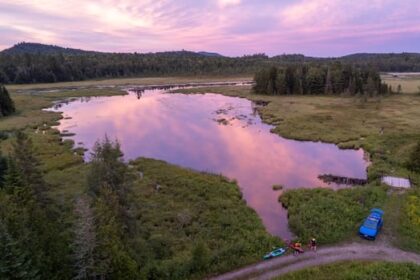Premier David Eby’s dream of fashioning British Columbia into an economic engine powerful enough to drive the Canadian economy took another step forward on Thursday. From Terrace, B.C., Prime Minister Mark Carney announced Ksi Lisims LNG and the North Coast transmission line would be added to the federal fast-tracking list. “We are the province that is bringing forward these projects that will make a meaningful difference in the Canadian GDP, that will make a meaningful difference in families being able to access high-paid jobs and will lift the prosperity of people, not just in this province, but right across the country,” Eby told reporters following Carney’s announcement. Eby repeated his expectation that the North Coast transmission line will help create 10,000 jobs and tens of billions of dollars in economic development. Carney lauded the potential of Ksi Lisims, a floating LNG plant, to generate $4 billion per year in gross domestic product and create “thousands of skilled careers.” Thousands of jobs and billions of dollars sound like a great deal — though B.C. and Canadian taxpayers will have to shell out billions first and relinquish input and oversight of those projects to lock in the promised benefits. Surely the federal and provincial governments would be keen to share the details of how, when and where we can expect to see those jobs and dollars materialize?Not so much.The North Coast transmission line is key to making Ksi Lisims “one of the world’s cleanest LNG operations,” according to Carney. By building hundreds of kilometres of high-voltage transmission line from Prince George, B.C., to Terrace, B.C., and then north to the border with Alaska, the province will be able to offer clean electricity to power both Ksi Lisims and multiple mining projects, Eby and his government have argued.But so far, Eby’s government has provided precious little detail on exactly how the North Coast transmission line will deliver its economic bounty — not the number of projects it would serve, the jobs each project would create nor the value of other economic benefits. The North Coast transmission line would connect Terrace, B.C., to Prince George, eventually powering Ksi Lisims LNG on Pearse Island, near the Nisg̱a’a village of Gingolx. Photo: Marty Clemens / The Narwhal Instead, it’s the NDP caucus that has offered the most in-depth estimate of the North Coast transmission line’s economic impact. An Oct. 28 press release from the caucus — the partisan entity that represents all NDP MLAs in the legislature, separate from their roles in government — outlined five projects the transmission line will serve: Four other proposed mines in northwest B.C. are also “among the mining projects along the North Coast transmission line that will benefit from access to clean power and improved grid reliability,” according to the Ministry of Mining and Critical Minerals.Aside from Cedar LNG, none of the projects linked to the North Coast transmission line have reached a final investment decision — meaning none are guaranteed to proceed. “I agree that we need to make sure that we expedite projects of provincial significance and ones that can actually have national significance,” South Surrey Independent MLA Elenore Sturko said. “But that doesn’t mean that we should entirely remove the ability for public input and consultation.” Transparency lacking when it comes to North Coast transmission line Energy Minister Adrian Dix claims the province has publicly made its case for fast-tracking the North Coast transmission line. He referred The Narwhal to an expression of interest call issued by BC Hydro in 2023.That call received 29 submissions, according to BC Hydro, with the highest number of submissions coming from the mining sector, while hydrogen production projects requested the most power overall. A government press release states those submissions outlined “5,000 megawatts of potential industrial load (about five times the capacity of the Site C hydroelectric project).” No other information about the projects interested in connecting to the North Coast transmission line has been made public. According to BC Hydro, “the information received from companies participating in the expression of interest process is considered commercially sensitive and will be kept confidential.” The government’s lack of transparency is unacceptable to Andy Hira, a political science professor at Simon Fraser University and director of the Clean Energy Research Group. “These are public decisions that are affecting the bottom line for B.C. taxpayers and they’re affecting our ability to create jobs and compete and so they should be made public,” he told The Narwhal shortly after Bill 31, the Energy Statutes Amendment Act, was introduced on Oct. 20. “Maybe there is a case to be made that the revenues from LNG will be so great that we should make sure we put enough electricity in them — despite the damning picture that they create in terms of climate change — but that case needs to be made in a public forum. It can’t be made in an arbitrary fashion by people who pretend to know better.” What we know — and don’t know — about demand for power on the North Coast Documents obtained by The Narwhal under freedom of information law provide a bit more detail about where the government is expecting the electricity carried by the 2,200-megawatt North Coast transmission line to go. Nearly half — 900 megawatts — could be dedicated to mines, according to a briefing note prepared for Eby in March 2024. Seabridge Gold requested 220 megawatts from BC Hydro for its KSM mine, a proposed copper and gold open pit project northwest of Stewart, B.C. The Galore Creek copper and gold mine — a joint venture between Teck Resources Ltd. and Newmont Corporation — could use 307 megawatts, according to the briefing note. That demand may be even higher, according to Michael Goehring, CEO of the Mining Association of BC. During a press conference on Oct. 20, Goehring said critical mineral and precious metal mining projects in the “Golden Triangle” in northwest B.C. could add 1,000 megawatts of new electricity demand to the provincial power grid. Mining projects in B.C.‘s “Golden Triangle” — a mineral- and metal-rich area in the province‘s northwest, could eat up nearly half the North Coast transmission line’s power. Photo: Chris Miller / Supplied by Salmon Beyond Borders Another 620 megawatts from the transmission line could go to LNG, according to the briefing note. That’s a bit more than enough to electrify Ksi Lisims LNG. The project was seeking 600 megawatts from BC Hydro at the time the briefing note was prepared (though the facility will likely run on natural gas when it begins operations). The Port of Prince Rupert could use up to 100 megawatts from the North Coast transmission line, Eby’s briefing note stated, with another 600 megawatts earmarked for potential hydrogen production projects. The Energy Ministry confirmed the transmission line’s capacity remains the same as the estimate in the briefing note, but would not provide updated estimates for potential electricity requests. If all of the projects on the North Coast do go ahead, B.C. could find itself in a significant energy deficit. BC Hydro now estimates demand for electricity will grow 1.4 per cent annually through 2050. That estimate does not include power for projects plugging into the North Coast transmission line, but does assume the province uses the powers Bill 31 would provide to limit power for hydrogen export projects, AI and data centres, and block new connections for cryptocurrency operations. Sturko argued British Columbians deserve answers about where the power for the project will come from and who will pay for it. “I’m really concerned that at the end of the day — whether it’s federal funding or provincial funding or it ends up on somebody’s hydro bill — this is all coming out of taxpayers’ pockets,” she told The Narwhal. “And we don’t really have the certainty that we even have the electricity to make this thing successful.” Updated Nov. 18, 2025, at 10:12 a.m. PT: This story originally stated Prime Minister Mark Carney’s announcement happened in Prince Rupert. While the event was originally scheduled in Prince Rupert, it was later moved to Terrace, B.C. The story has been corrected. Recent Posts Deer are destroying B.C. island ecosystems. Indigenous hunting could be the solution Nov. 18, 2025 7 min. read A new study finds hyperabundant deer are pushing rare ecosystems to collapse, and Indigenous hunting… B.C.’s ‘economic engine’ is revving — but do we need the power? Nov. 18, 2025 6 min. read The provincial government has made big claims about the benefits the North Coast transmission line… For Nova Scotia, offshore wind could be an economic boon — with unknown environmental impacts Nov. 17, 2025 11 min. read As the federal government considers fast-tracking Wind West Atlantic Energy, residents hope for economic transformation,…
B.C.s economic engine is revving but do we need the power?












